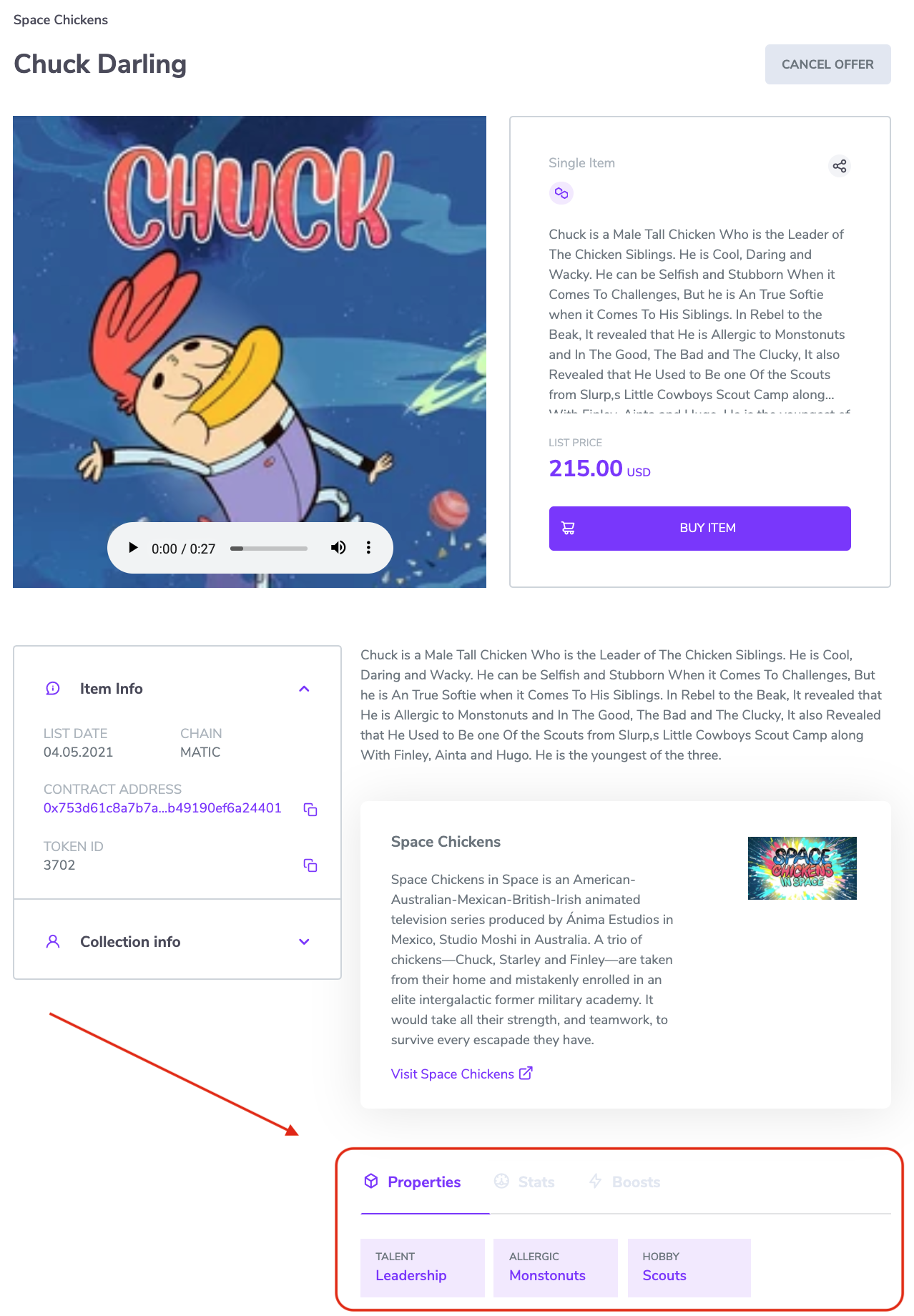Attributes
NFT Properties / Stats / Boost
In the NFT template (token type) you can define a list of attributes for an NFT. To make it simple you can define an attribute as one of three types, a property, a stat, or a boost.

NFT Properties
Each type has its own place in the NFT detail on the market, and each type has its own display characteristics.
Read how to update, add, and delete the attributes of an NFT.
Properties
The properties section is mostly used to display text-based attributes such as the type or category of an item, a team, certain year, or a rarity.

Properties of an NFT
"attributes": [
{
"type": "property",
"name": "Talent",
"value": "Leadership"
},
{
"type": "property",
"name": "Allergic",
"value": "Monstonuts"
},
{
"type": "property",
"name": "Hobby",
"value": "Scouts"
}
]Stats
The stats section is used to display certain stats and metrics, such as the level of a certain item, and the amount of defense, power, or top speed a certain item possesses.
When a stat also has a max value defined it will be visualized as a progress bar, otherwise, it will be shown as a card.

NFT Stats
"attributes": [
{
"type": "stat",
"name": "Age",
"value": "3"
},
{
"type": "stat",
"name": "Cool",
"value": "9",
"maxValue": "10"
},
{
"type": "stat",
"name": "Daring",
"value": "8",
"maxValue": "10"
},
{
"type": "stat",
"name": "Noise",
"value": "8",
"maxValue": "10"
}
]Boosts
Boosts is a category to display gains that are achieved by possessing or using a certain item. It usually is accompanied by a positive or negative identifier. Examples of a boost are the increase or decrease of speed, and armor but equally, it can be a reduction of certain fees or an increase in chance.

NFT Bossts
"attributes": [
{
"type": "boost",
"name": "Crafting",
"value": "+5"
},
{
"type": "boost",
"name": "Leadership",
"value": "+10"
}
]Data Structure
Signature:
"attributes": [
{
"type": "property",
"name": string,
"value": string
},
{
"type": "stat",
"name": string,
"value": string,
"maxValue": string
},
{
"type": "stat",
"name": string,
"value": string,
},
{
"type": "boost",
"name": string,
"value": string
}
]Example:
"attributes": [
{
"type": "property",
"name": "Type",
"value": "Hero"
},
{
"type": "property",
"name": "Team",
"value": "Avengers"
},
{
"type": "stat",
"name": "Level",
"value": "7"
},
{
"type": "stat",
"name": "Strength",
"value": "88",
"maxValue": "93"
},
{
"type": "stat",
"name": "Speed",
"value": "74",
"maxValue": "100"
},
{
"type": "boost",
"name": "Defence",
"value": "+5"
},
{
"type": "boost",
"name": "Rage",
"value": "-5"
}
]Compatibility
In order to be compatible with the NFT standards on the market, in terms of attributes, our system takes the above JSON structure and transforms it into a JSON that is compatible with the following attribute standards:
This results in an easy-to-use property structure, which provides consistency and compatibility with any NFT service on the market, such as wallets, and marketplaces.
Updated 2 months ago